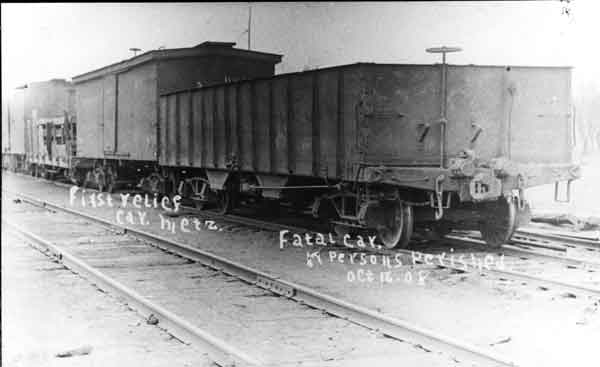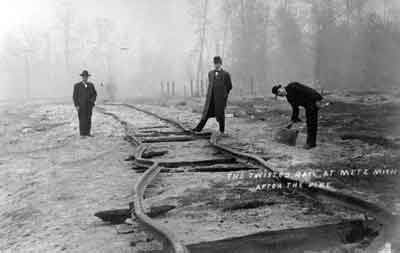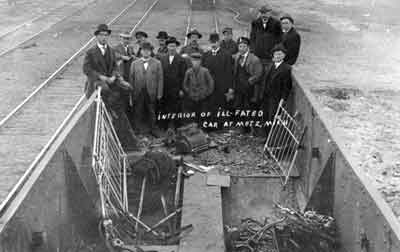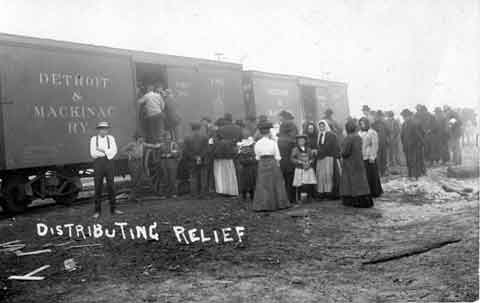The Metz Fire of 1908 started somewhere west of Millersburg,
Michigan, in the late
morning of October 15, 1908. Pushed by gale force winds,
by that night the fire had burned
its way to the Lake Huron shoreline, a
distance of about 35 miles. In its wake, 37 people lay dead, the
once-prosperous village of Metz was a charred and smoking ruin, and at least 134
families—about 700 people—found themselves homeless.
The single worst tragedy of the fire occurred just a few blocks
southeast of Metz. The Detroit & Mackinac Railroad had sent a train into Metz
to evacuate the residents. About 40 residents, mainly women and children,
boarded the train, often bringing their prized possessions with them. Trunks,
beds, and dressers were loaded into the rail cars, and a local saloon owner even
held up the train’s departure until he had safely stowed his stock of liquor.
Many of those trying to escape the flames took refuge in a open gondola car.

By the time the train left Metz, the area around the village was
engulfed in flames. At Nowicki’s Siding, just southeast of Metz, huge stacks
of cedar posts, railroad ties, and hemlock bark were burning on both sides of
the tracks. The heat was so intense that it had warped the steel rails, and the
train derailed amidst the raging inferno.

Some of those aboard the train were able to escape, often by
crawling back along the tracks. For 12 people, however, the gondola car became
their crematorium. When the fire subsided and rescuers could get to the train,
all that was left of those in the gondola car were piles of ashes and pieces of
bone. Many of the piles of ash and bone were pitifully small, the remains of
the 9 children who perished with their mothers in the fire.

The above photo shows the gondola car on the day after the
fire.
Because of
the extent of the losses at Metz, the fire quickly came to be referred to as
“TheMetz Fire,” but it devastated an area well beyond the boundaries of the
little farming and lumbering village. Burning branches and embers spread the
fire to the northern reaches of Presque Isle County, threatened the county seat
at Rogers City, burned to the outskirts of the City of Alpena, and jumped across
Grand Lake before it finally burned itself out at the Lake Huron shore.
Even before the last of the fires were out, people throughout
Michigan, and beyond, heard of the terrible plight of those in the Metz area.
One newspaper reported, “The Metz refugees are sadly in need of warm
underclothing, shoes and stockings, bedding, and stoves. The food supply is
sufficient for a few days, but no longer. Lumber has been sent, but more is
needed. Tools are scarce. Cooking tinsels are few. Hay and grain for the
remaining horses and cattle must be procured. In the immediate vicinity of Metz
there are 84 families without homes, nearly all penniless and in want.” On top
of that, winter wasn’t far off. Records kept at the Presque Isle Lighthouse
tell us that the first ice formed on the lake on October 31, a sure sign that
the long northern winter was not far off.

The D&M Railroad immediately began to bring relief supplies into
the area, and their construction crews began building 16’x20’ “relief shacks” to
house those who had survived the fire. The shacks were built of rough boards
covered with tar paper. Each shack was equipped with a small wood stove used
both for cooking and heating.
Relief
supplies quickly began to pour into Metz and the surrounding area. Among the
first shipments brought in by the D&M was clothing donated by residents of the
wealthy Detroit suburb of Grosse Pointe. There are
several photos of female fire survivors at Metz dressed in high-style evening
wear that had been donated by the wealthy ladies in Grosse Pointe. For many of
the women in Metz, it was undoubtedly the finest clothing they’d ever worn.
Despite the
obvious hardships, most of those who lost their homes and businesses that tragic
day in October of 1908 rebuilt. Metz is a much smaller community today than it
was in 1908, but many of the residents are descendants of those hearty pioneers
who rebuilt their lives after the fire.
It was never
determined what caused the fire. It could have started with a lightening
strike, spontaneous combustion in a sawdust pile, a spark from the steam engine
of a passing train, a plug of smoldering tobacco from a careless lumberjack’s
pipe, or a brush fire set by a farmer to clear land. While many people called
for the enactment of stronger fire laws, nothing much happened in Lansing until
the 1930’s.